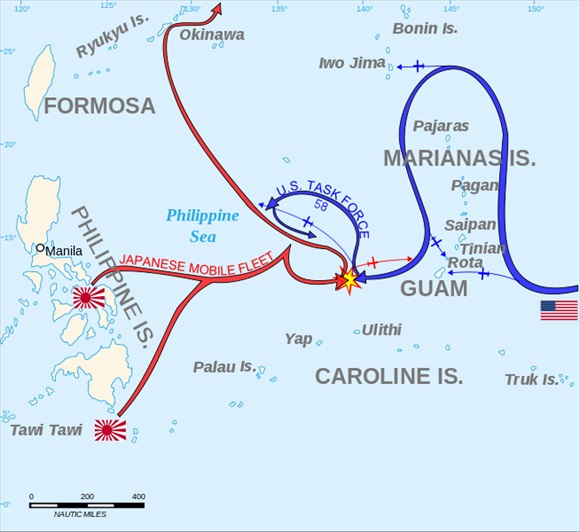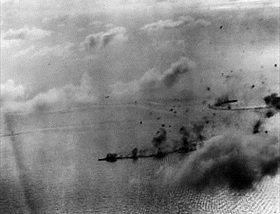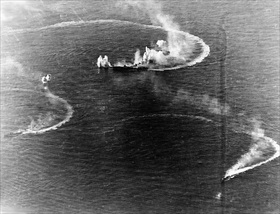U.S. MORTALLY WOUNDS JAPANESE NAVY
Philippine Sea, North Pacific Ocean • June 19, 1944
On this date in 1944 a huge gale hit the two gigantic artificial harbors known as Mulberry harbors that the British had built in England, floated across the English Channel, and deposited on Normandy’s beaches several days after the Allies’ June 6 invasion. The gale inflicted losses greater than the Germans had been able to inflict since D-Day. The Mulberry harbor at Omaha Beach was demolished, 800 ships were lost or beached, and more than 140,000 tons of supplies were destroyed. Allied soldiers were down to two days of ammunition. The nearest replacement harbor was German-held Cherbourg on the Cotentin Peninsula, 25 miles northwest of Utah Beach, the westernmost of the five invasion beaches.
As Allied forces struggled to replenish war material for their push off the Normandy beachheads, U.S. Marines and Army troops on the other side of the globe assaulted Japanese bases on Saipan (starting on June 15, 1944), Guam, and nearby Tinian in the Mariana Islands, some 1,200 miles southeast of the Japanese Home Islands. Japan’s First Mobile Fleet steamed into the Philippine Sea northwest of the Marianas with three chief aims: destroy U.S. naval power in the area, deny Americans a foothold inside Japan’s so-called inner defense line, and reinforce Japanese holdouts in the Marianas.
The Battle of the Philippine Sea began on this date, June 19, 1944. It was the greatest flattop duel of the war, nearly four times as big as the Battle of Midway (June 4–7, 1942). Admiral Raymond A. Spruance’s U.S. Fifth Fleet, comprised of 15 fleet carriers and 956 planes, 7 battleships, 28 submarines, and 69 destroyers, as well as several light and heavy cruisers, engaged nine-tenths of Japan’s fighting fleet, which included 9 carriers with 473 planes, 5 battleships, several cruisers, and 28 destroyers. The two-day naval and air battle signaled the effective demise of the Imperial Japanese Navy’s carrier force. Three of Japan’s nine flattops were damaged. Three carriers were sunk—two by submarines (Japan’s largest, the Shokaku, and Vice-Admiral Jisaburo Ozawa’s carrier flagship, the Taihō)—for a combined loss of 2,922 seamen. Furthermore, 426 Japanese carrier-based planes were destroyed (they were outclassed by the Navy’s new Grumman F6F Hellcat fighters), along with most of Japan’s carefully hoarded cadre of trained aviators. The lopsided U.S. victory in the skies over the island of Guam (close to 400 Japanese planes lost as opposed to 26 American) entered legend as “The Great Marianas Turkey Shoot.” Following its crushing defeats on June 19–20, the enemy fleet retreated full speed toward Okinawa. Exactly a month later Japan’s prime minister, Gen. Hideki Tōjō, resigned his office in disgrace.
Victories ashore provided the U.S. with B‑29 Superfortress bases more secure than those in mainland China, and within easy striking distance (1,500 miles) of Tokyo, the Japanese capital with its 3.5 million inhabitants and thousands of small-to-large war-related industries. The Marianas conflict essentially ended on August 10, 1944, after Tinian and Guam had been secured. That victory gave the U.S. the final advantage necessary to defeat Japan’s war machine and bring an end to the Pacific conflict on August 15, 1945, the date Emperor Hirohito (posthumously referred to as Emperor Shōwa) ordered his country’s surrender.
![]()
Battle of the Philippine Sea, June 19–20, 1944: U.S. Navy Waves “Sayonara” to Japanese Navy
 |
Above: Map of the Battle of the Philippine Sea, June 19–20, 1944.
 |  |
Left: Japanese Carrier Division Three under attack by carrier planes from Adm. Marc Mitscher’s Task Force 58, part of Spruance’s Fifth Fleet, June 20, 1944. The battleship in the lower center is either the Haruna, sunk on June 20 along with the escort carrier Hiyo, or the Kongō, torpedoed and sunk on November 21, 1944. The light carrier Chiyoda is at right. Damaged in the Battle of the Philippine Sea, the Chiyoda was sunk on October 25, 1944, with all hands at the Battle of Cape Engano, one of four major engagements that comprised the Battle of Leyte Gulf (October 23–26, 1944).
![]()
Right: Japanese aircraft carrier Zuikaku (center) and two destroyers maneuvering while under attack by U.S. Navy carrier aircraft, June 20, 1944. Zuikaku was hit by several bombs during these attacks, but the flattop survived. She was sunk on October 25, 1944, by air attack in the Battle of Leyte Gulf—the last survivor of the six Japanese carriers that had attacked Pearl Harbor on December 7, 1941.
Battle of the Philippine Sea, June 19–20, 1944
![]()

 History buffs, there is good news! The Daily Chronicles of World War II is now available as an ebook for $4.99 on Amazon.com. Containing a year’s worth of dated entries from this website, the ebook brings the story of this tumultuous era to life in a compelling, authoritative, and succinct manner. Featuring inventive navigation aids, the ebook enables readers to instantly move forward or backward by month and date to different dated entries. Simple and elegant! Click
History buffs, there is good news! The Daily Chronicles of World War II is now available as an ebook for $4.99 on Amazon.com. Containing a year’s worth of dated entries from this website, the ebook brings the story of this tumultuous era to life in a compelling, authoritative, and succinct manner. Featuring inventive navigation aids, the ebook enables readers to instantly move forward or backward by month and date to different dated entries. Simple and elegant! Click 











